2012 VOLKSWAGEN GOLF PLUS instrument panel
[x] Cancel search: instrument panelPage 57 of 541
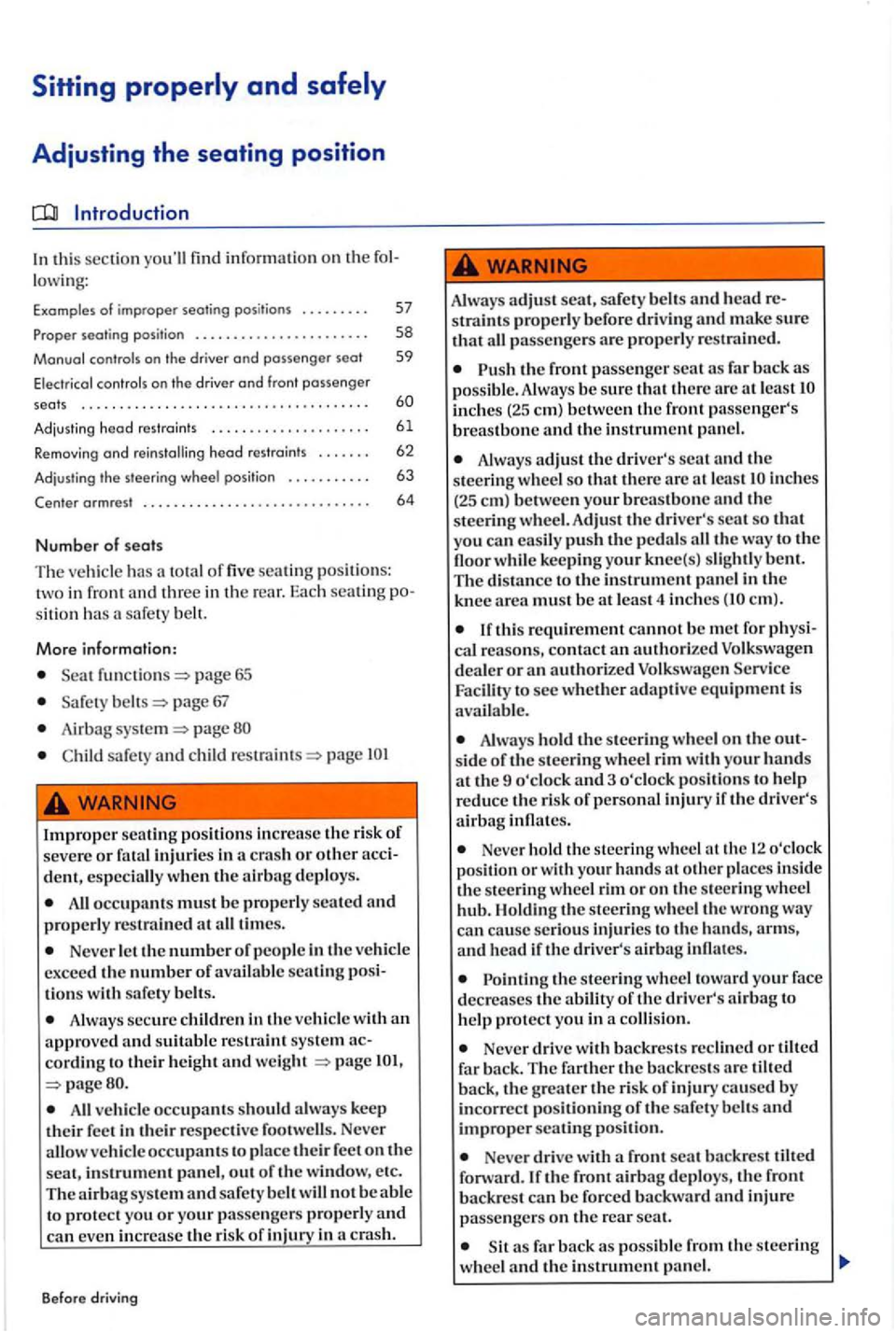
Sitting properly and safely
Adjusting the seating position
Introduction
In thi s sect io n you'll find information on th e lowing:
Examples of improper sealing positions . . . . . . . . . 57
Proper seating position . . . . . . . . . . . . . . . . . . . . . . . 58
Manual controls on the driv er and passenger
. . 62
Ad jus ting the s teeri ng wheel positio n . . . . . . . . . . . 63
Center a rmrest . . . . . . . . . . . . . . . . . . . . . . . . . . . . . 64
Number o f
Th e ve hicl e has total of five seating positio ns: in fron t and three in the re ar. Each sea tin g sition saf ety be ll.
More information:
pag e 65
page 67
Airbag page
sa fe ty and child page
Improper se atin g pos itions increase th e risk of severe or fata l injurie s in a cras h or other dent, especially w hen th e a irbag deploys.
All occupants mus t b e properly seate d and properly restra ined at all tim es.
Never lett h e number of people in the veh icle
excee d the number of availabl e seatin g tions with sa fe ty belt s.
Alw ays secure childr en in the ve hicl e with an approve d and suitable restraint system cord ing to t heir he igh t and weight
All vehi cle occupants shou ld alway s keep
th eir fee t in their r espective footwell s. Neve r
a llow veh icle occ upants to place their feet on the scat, in strume nt panel, out of th e w ind ow, etc. The and eve n in crease the risk of inju ry in a cras h.
B efore driving
Always adjust scat, sa fcry belts and head straints properly befo re drivin g and m ake sure that passe nge rs are prope rl y restrai ne d.
the front passenger sc at as
inch es (25 e m) between th e front passenge r's breastbone and the instrument panel.
Alway s adjus t the driver's scat and th e
s teeri ng wheel so that there arc at least
em).
or an authorized Volkswagen Facilit y to sec w hether adaptive equipment is availabl e.
Alwa ys hold the steerin g wheel on the side of th e steering wheel rim with your hand s at the 9 o'clock and 3 o'clock positi ons to help reduce the risk of p ersonal inju ry if th e dri ver's
a ir bag inflates.
Neve r hold the stee ring whee l at the 12 o'clo ck
po siti on or with your hand s at o th er places insid e
the stee ring wheel rim or o n th e stee rin g w hee l hub. the steering w heel the wrong way
ca n ca use serio us in juries to the hands, arms,
and h ea d if th e driver 's airbag inflates.
t h e s teeri ng whee l toward your face
d ec reases the abiliry of the driver's airbag to
h elp prot ect yo u in a co llisio n.
Never drive with backre sts reclin ed or tilt ed
far back . T he farther th e backr ests arc tilted back, the g reater th e r is k of injury caused by
in correc t positioning of th e safet y belt s and
improper seati ng position.
Never drive with a front seat backres t tilted
forward. If the front airbag deploy s, th e front
backres t ca n b e forced backward and injure
p asse ngers on th e rear scat.
far back as possibl e from the s tee ring
whee l a n d the in strument panel.
Page 82 of 541
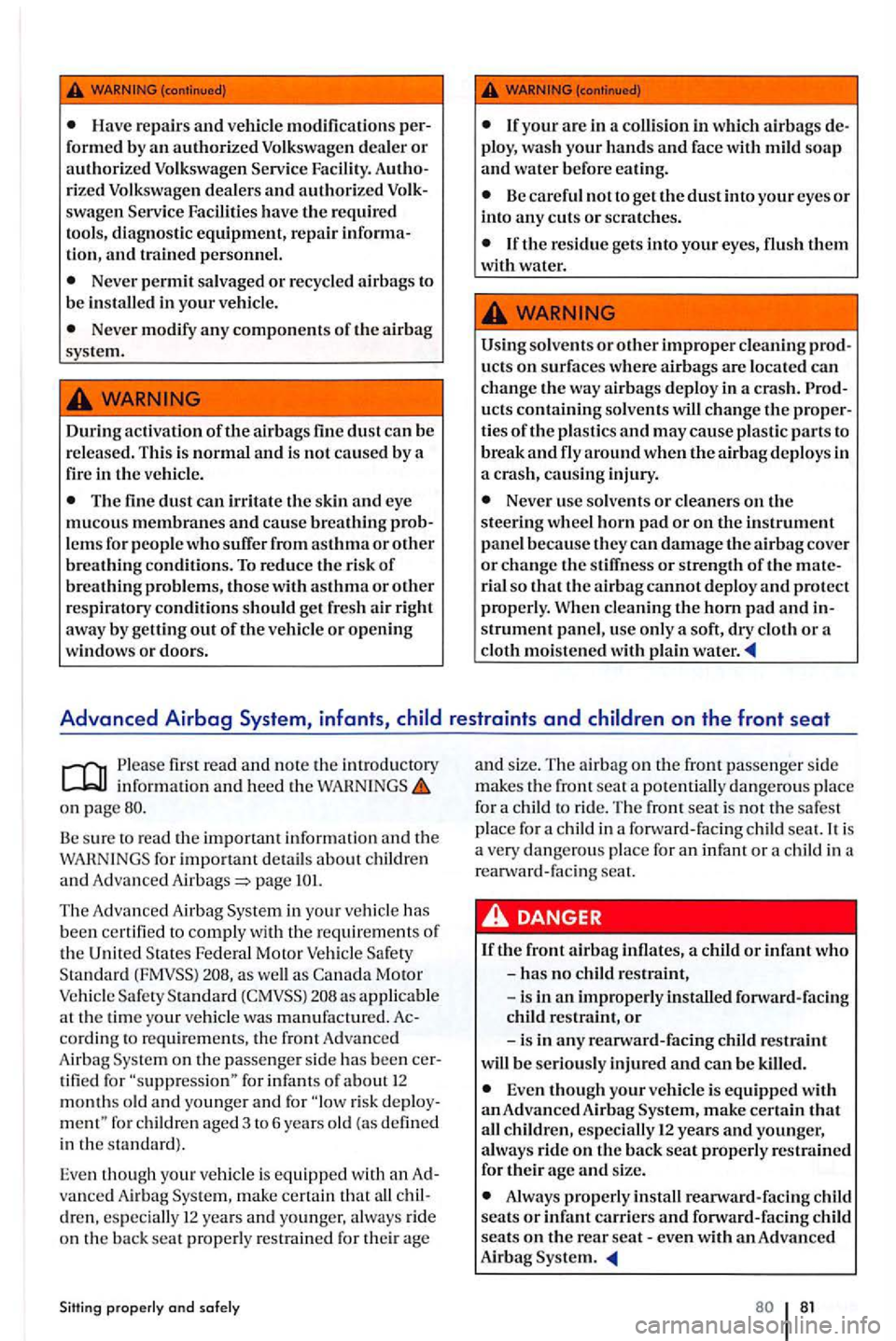
Have repairs and vehicle modification s
rized Volkswagen dealers and authorized swagen Facilities have the required
tool s, dia gnostic equipment, repair tion, and trained personnel.
Never permit salvaged or recycled airbags to be installed in your veh icle.
Never modify any components of the airbag syste m.
During activation of the
The fine dust can irritate the skin and eye muco us membranes and cause breathing lems for people who suffer from asthma or other breathin g conditions. To reduce th e risk of breathing probl em s, those with asthma o r o th er
r es piratory
Be careful no t t o ge t the dust into your eyes or
into any c uts or sc ratches.
Using so lve nts or other improper cleaning
u cts containing so lvents w ill ch ange the ti es of the plastic s and may cause plastic parts to break and fly around when the airbag deploys in a crash, causin g injury.
Never usc so lven ts or cleaners on th e
s teering wheel horn pad or on the instrument pan el b eca use they ca n damage the airbag cover or change the s tiffness or strength of the rial so that the airba g cannot deploy and protect properly. When cleaning the horn pad a n d strument panel, use onl y a soft, dry cloth or a
cloth moistened w ith plain water.
Please first read and note th e introductory informatio n and heed the WARN INGS on
Be sure to read the important inform ation and th e for important detail s about child ren
and Adva nce d Airbags
in you r ve hicl e has
been ce rtifi ed to comply wit h th e requirement s of the Unit ed Federal Moto r Vehicle as well a s Motor Vehicl e as a pplicabl e
at the time your vehicle was manufactured. co rding to req uirement s, th e front Advance d
A ir bag on th e passeng er side h as been tified for for infant s of about 12
months old and you nger and for risk for ch ildren aged 3 to 6 yea rs old {as defined
in the stand ard ).
Even th ough your vehicl e is equipp ed w ith an vance d Air bag mak e ce rtain that all dre n, es pecially 12 years and younge r, a lways ride
o n th e back seat properly restra ined for their a ge
Sitting properly and safely
and size. The airb ag on the front passenge r side m ak es the fron t seat a potentially dangerou s pla ce for a child ride. Th e front seat is no t th e sa fest
p lace for a child in a fo rward -faci ng chil d seat. is
a very dangerous place for an in fant or a child in a
r earward-fac ing sea t.
is in an improp erl y in stall ed for ward-faci ng
child res traint, or
in an y rearward- facing child restraint
will
be se riously injur ed and can be kill ed.
Eve n though your vehicl e is equipped with an Advance d Air bag make certain that aU children, especia lly years and you nger,
a lwa ys rid e o n the back seat properly restrained
for their age and s ize.
Always properly install reanvard-facing child seats or infant carriers and forward -faci ng c hild
s eats on the rear seat-even with an Advanced
81
Page 87 of 541
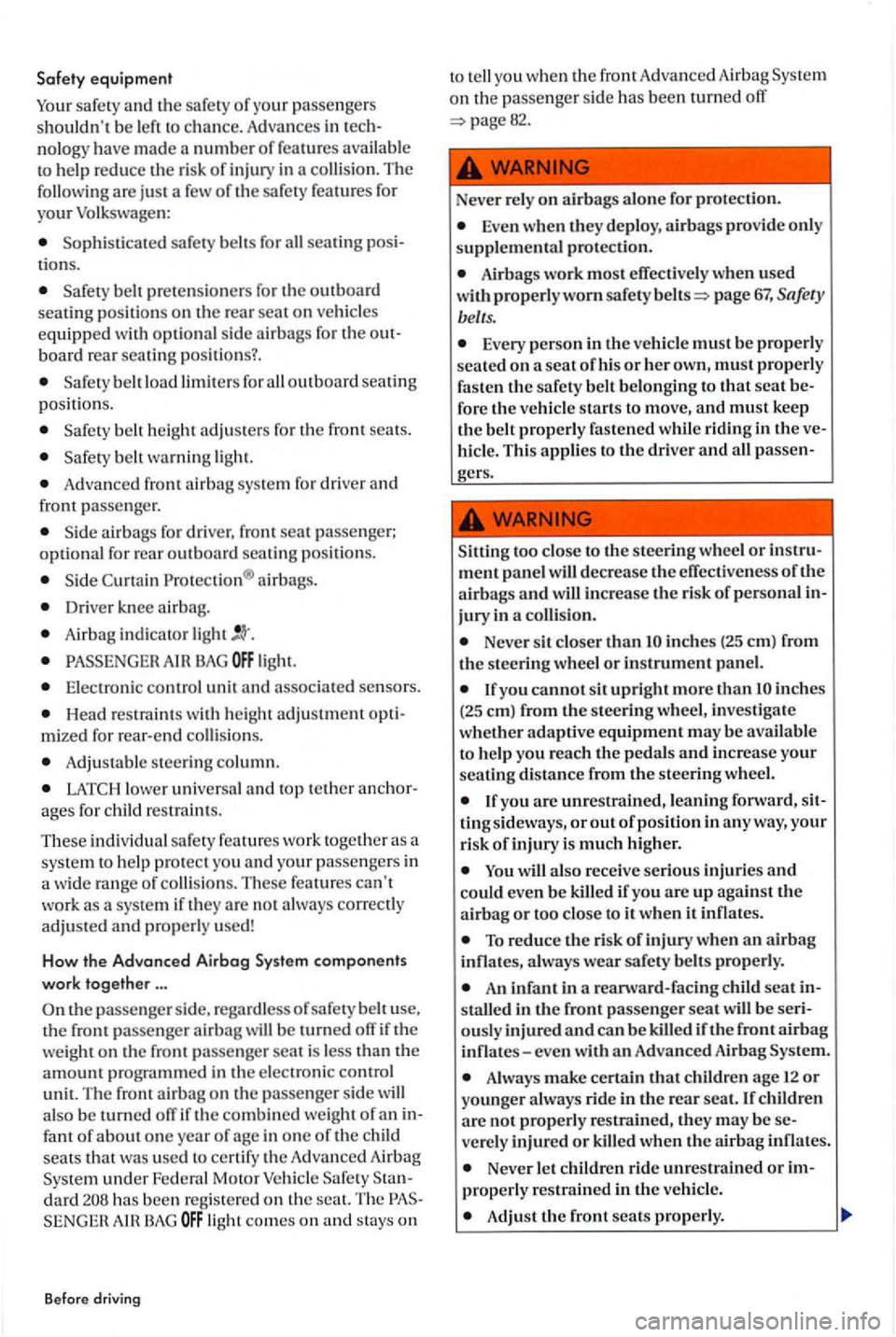
Safety equipment
safet y and the s afe ty of your p assenge rs shouldn 't be l eft to c han ce. Advances in tech
nolo gy have made a numb er of featur es available help reduce the ris k of injury in a collisio n. The follo wi ng are just a few o f th e sa fe ty features for your Volkswag en :
Soph is ticated safety belts for all seating posi
tions.
Safety belt pretensio ne rs for the outboard seatin g positi ons on the rea r seat o n ve hicl es equipped with optional side a irbags for the o ut
board rear seating positi ons?.
belt load limit ers fo r all outb oa rd seating
positions.
b elt h e ig ht adju ste rs for the front
belt warning light.
A dvanced front airba g sys tem for driver and fro nt passe nger.
airbag s.
Driver knee airbag .
Airbag indicator light
BAG light.
Ele ctronic cont rol unit and asso ciat ed senso rs.
Head res traint s w ith heig ht adju stment opt imized for rear -end collisio ns.
Adju stabl e stee rin g column.
lo w er univer sa l and top te th er an chor
age s for child restraint s.
These individual safety wo rk tog eth er as sys te m t o help pro tect yo u and your passenger s in w id e rang e of collisio ns. Th ese features can't
work as a syste m if they are no t a lwa ys correctly
adju ste d and prope rly used!
How the Advanced Airbag System components
work together ...
in
fan t of about one yea r o f ag e in one of th e c hild
seats u sed to certif y th e Adva nced Airb ag under Federa l Motor dard h as been regis te re d on th e seat. Th e AI sta ys on
Before driv ing
o n th e passenge r side has been turned off
Neve r rely on airbags alone for protec tion.
Even wh en they depl oy, airbags provide only
supplemental protection.
Airbag s work most effec tive ly when used with properly worn safe ty page 67, Safety
belt
s.
Every person in ve hicle must be prope rl y
se ated on a seal of his or he r own, must prope rl y
fasten the s afety belt belonging to that seat be
fore th e ve hicle start s to move, and must keep the belt properly fas tened w hil e riding in the ve
hicle. This applies to the dri ver and all passen-
too close to the steering wheel or instru
m ent panel will dec rease the effectiveness of th e
airbags and will increase the risk of personal in
jury in a coUision .
Never sit closer than inche s (25 em ) from the s teering whee l or instrument panel.
If yo u cannot sit upright more th an inch es (25 em) from the steering wheel, investigat e
whether adaptive equipment may be ava ilable
to help you reach the pedal s and increase your seating di stance from the steering wheel.
If you are unres trained , leaning fonvard, sit
tingsideway s, or out of position in anyway, your ris k of injury is m uch higher.
To reduce the risk of injury w hen an airbag always wear safety belt s properl y.
A n infant in a reanvard-facing child seat in
s talled in the front passe nge r seat w ill be seri
ously injured an d ca n b e killed if the front airbag
inflates-even with an Advanced Airbag
Always make certai n that children age 12 or younger alway s ride in the re ar seat. If childre n
are not properl y re stra in ed, they may be se
ve rel y injured or killed when th e infl ates.
Never le t children ride unres trained or im properly re strain ed in th e ve hicl e.
Adjust the front seats properly.
Page 88 of 541
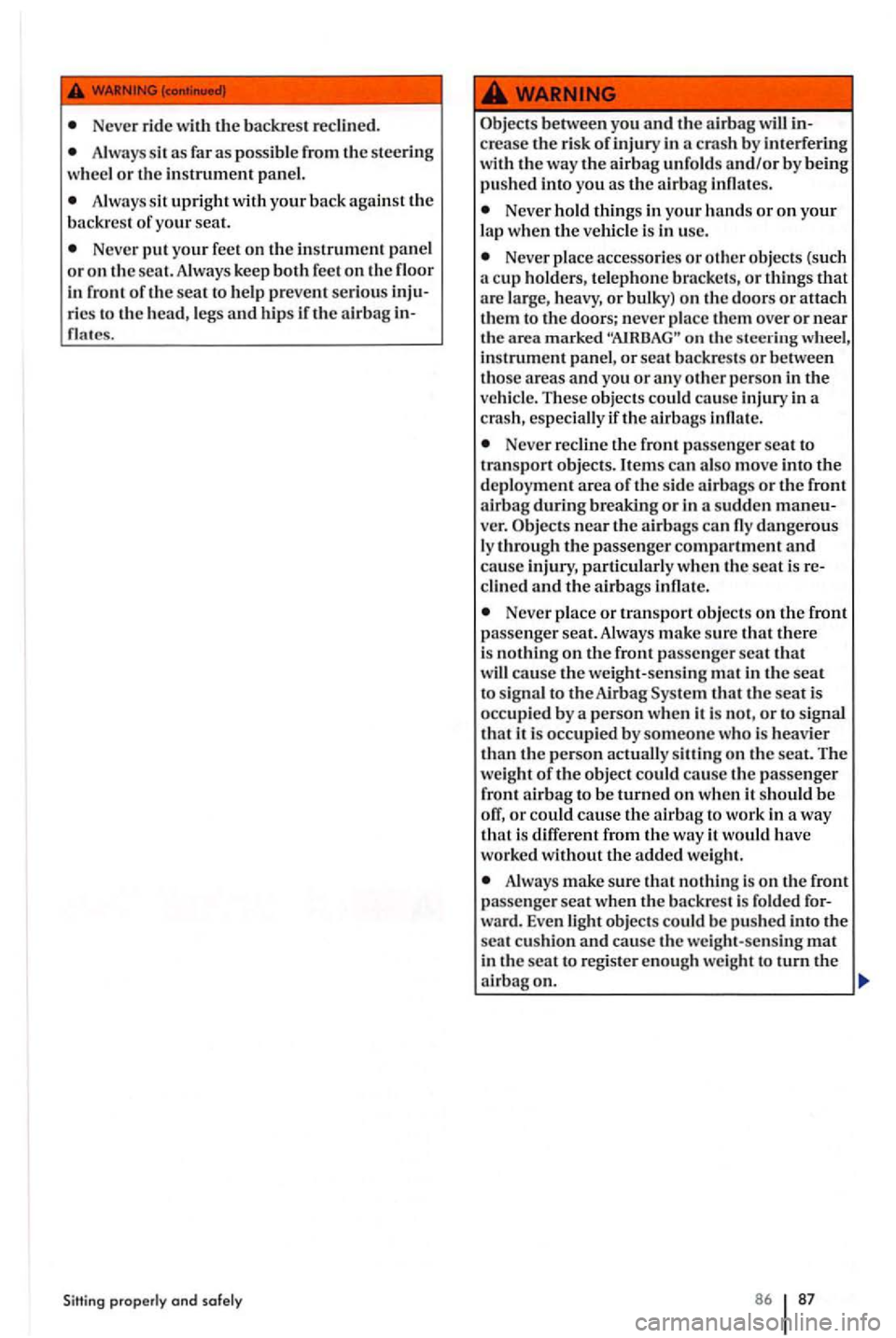
Never rid e with th e ba ckres t reclined.
Always sit p ossib le from the steering
w heel or th e in strument pan el.
A lways sit upri ght with your back
Never your feet on the instrument panel or on th e sc at. Alwa ys keep both fee t on the floor
in front of th e seat to help prevent serious
flat es.
Obj ects between you the airb ag
Never hold things in your hands or on your lap when the ve hicl e is in usc.
Never place accessories or other objects (su ch cup hold ers , telephone bracke ts , or thing s that
a re heavy, or bulky) o n th e door s or attach
th em to the doors; neve r place th em over or near the area marked ''AIR
Never re cline
side airbags or the front
ai rb ag during breaking or in sudden ver. Obje cts near the airbags can n y dangerous
l y through the passenger comparlment and
ca use inju ry, particularly when th e seat is cli ne d and the airbags innat e.
Never place or transport obj ec ts on the front
pa sse nger seat. Alwa ys make sure
is different from the it would have
wo rked without the added we ig ht.
Always make sure that no thin g is o n th e front
passenger seat when th e ba ckre st is folded
w ard. Even light ob jec ts co uld be pus hed into th e
s ea t c u shion and cause the weig ht-sen sing mat in the scat to register enough weig h t to turn the
airbagon.
86 87
Page 91 of 541
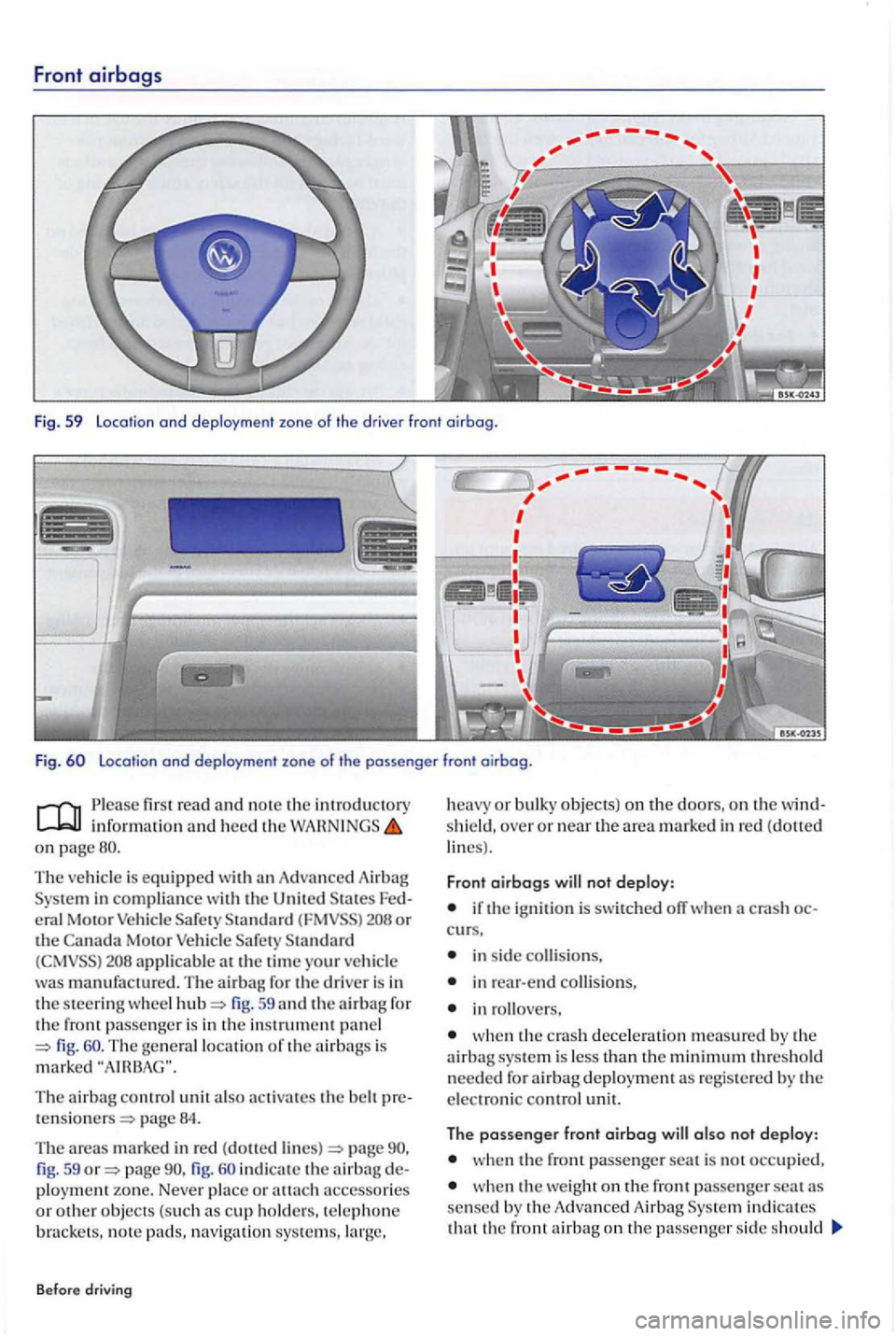
Front airbags
Fig . 59 location ond deploy ment zone of the driver front oirbog.
Fig .
60 location and deployment zone of the passenger front oirbog .
read and no te the introductory
on page 80 .
The ve hicle is equippe d w ith
208 applicable at the tim e your vehicl e was manufactured. The a irbag for the driver is in the steerin g fig. 59 and the for the fron t passeng er is in the instrument panel 60 . The gene ra l locatio n of the air bags is
m arked
The activa tes the belt te n sione rs page 84.
Th e a r
eas marke d in re d (do tted page fig . 59 page fig . indi cate the airb ag plo ym ent zone. Never place or
naviga tion systems,
Before driving
heavy or bulky objects ) on the doors, on the s hi eld , o ve r or near the area marked in re d (dotted lin es) .
Front oirbogs not deploy:
if th e ig n itio n is switched off when cra sh
in sid e collision s,
in rear-end collis ions,
in roll overs.
when the cra sh d ecele rat io n measured by the airbag syste m is less than the minimum threshol d nee d ed f or airbag deployment as regis te red by the
e lectroni c control unit.
The passenger front oirbog
when the front passenger seat i s not occupied,
w hen the weight on the fron t passenger seat as sensed by the Advanced Airbag in dica tes that t he front airbag on the passe nge r sid e should
Page 93 of 541
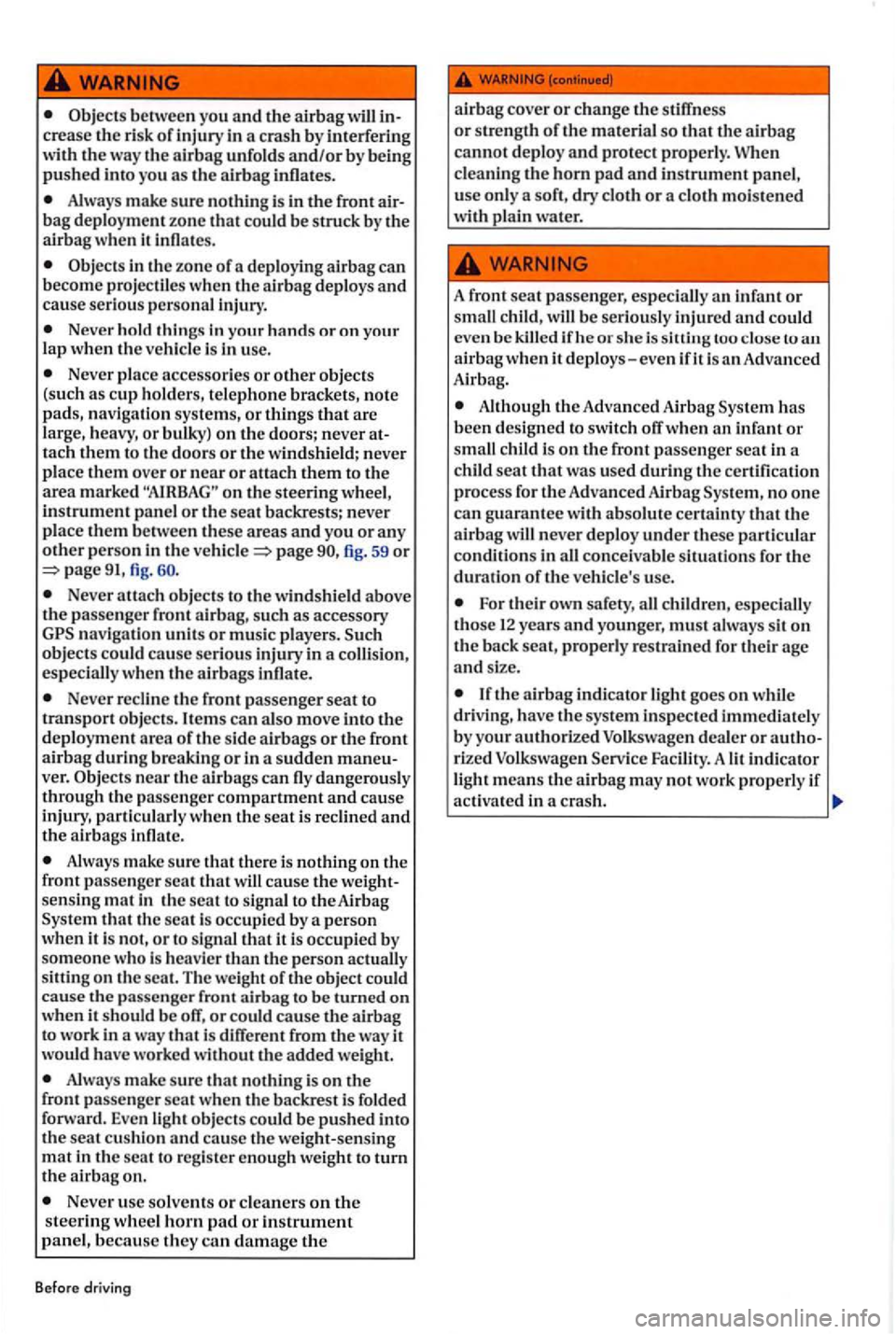
Always make sure nothing is in the front airbag deploym ent zone that could be struck by the airbag when it inflates.
Never hold things or on your lap when the vehicle is in use.
Never place accesso ries or other objects
(such as cup holders, tel ephone brackets, note pads, navigation systems, or things that are large, heavy, or bulky) on the doors; never attach them to the doors or the windshield; never place th em over or near or attach them to the area marked
fig. 59 or 91, fig.
Never attach objects to the windshield above the passenger front airbag, such as accessory navigation units or music player s.
Never recline th e front passenger seat to transport objects. can also move into the deployment area of the side airbags or the front airbag during breaking or in a sudden maneuver. near th e a irbags can fly dangerously through the pass enger compartment and cause injury, particularly when the seat is reclined and the airbags inflate.
Always make sure that there is nothing on the front passe nger seat that will cause the weightsensing mat in the scat to signal to theAirbag that the scat is occupied by a person when it i s not, or to signal that it is occupied by someone who is heav ie r than the person actually
sitting on th e sca t. The weight of th e object could cause the passenger front airbag to be turned on when it should be off, or could cause the airbag to work in a way that is differ ent from the way it
would have worked without the added weight.
Alwa ys make sure that nothing is on the front passenger seat when the backrest is folded
forward. Even light objec ts could be pushed into the seat cu shi on and cause th e weight-sensing mat in the seat to re gister enough weight to turn the airbag on.
Never usc solvents or cleaners on the steering wheel horn pad or instrument panel, because they can damage the
Before driving
airbag cover or change the stiffne ss or strength of the material so that the airbag cannot deploy and protect properly. When cleaning the hom pad and instrumen t p anel, use only a soft, dry cloth or a cloth moist en ed
with plain water.
A front seat passenger, especially an infant or small child, will be seriously injured and could
eve n be killed if he or she is
Although the Advanced Airbag has been designed to switch off when an infant or child is on the front passenger seat in a child seat that was used during the certification
process for the Advanced Airbag no one can guarantee with absolute certainty that the airbag never deploy under these particular conditions in all conceivable situations for the duration of the vehicle 's use.
For their own safety, all children, especially those 12 years and younger, mus t always sit on the back seat, properly restrained for their age and size.
Facility. A lit indicator light means the airbag may not work properly if
activated in a crash.
Page 97 of 541

To reduce the risk of se riou s injury, make sure
tl1at the or
front
p asse nger seat and
SENGER
rized Volkswagen dealer or swagen Service Facility immediately.
light or
on the front passenger seat.
install the child restraint system on the rear seat!
first re ad and note th e introdu ctory
on pag e
Changes in weight on the passenger seat during travel ca n switch the passe nger front airbag on or so that it does no t deploy when it should or deplo ys when it should
o n your la p or trans
port things on the passenger seat. weight registered b y the weight-sensing
Never reduce weight on the passenger seat
by hold ing the handle above the passenger door,
suppo rting body weight on the armrest , or by holdin g th e grab handl e on the instrument panel.
Alway s m ake sure that child restraint s are correc tly regi stered by the weight-sensing mat. If the statu s of tl1e Advanced Airbag System has
changed while the vehicl e is moving, the SENGER light blinks for about 5
seconds to catc h the dri ver's attention. If this happens, always stop as soo n as it is safe to do so and check t o make sure that the airbag on/off status is correct for the passeng er riding on the
front passe nger seat
Fig . 62 Dep loymen t zones of the front ond rear side
o irbogs.
Th e side airbags are in th e ba ckre st paddin g of the
drive r a nd passe nge r fig. 61. Dep endin g on
t h e model, th e re al so migh t be side airb ags
Page 226 of 541
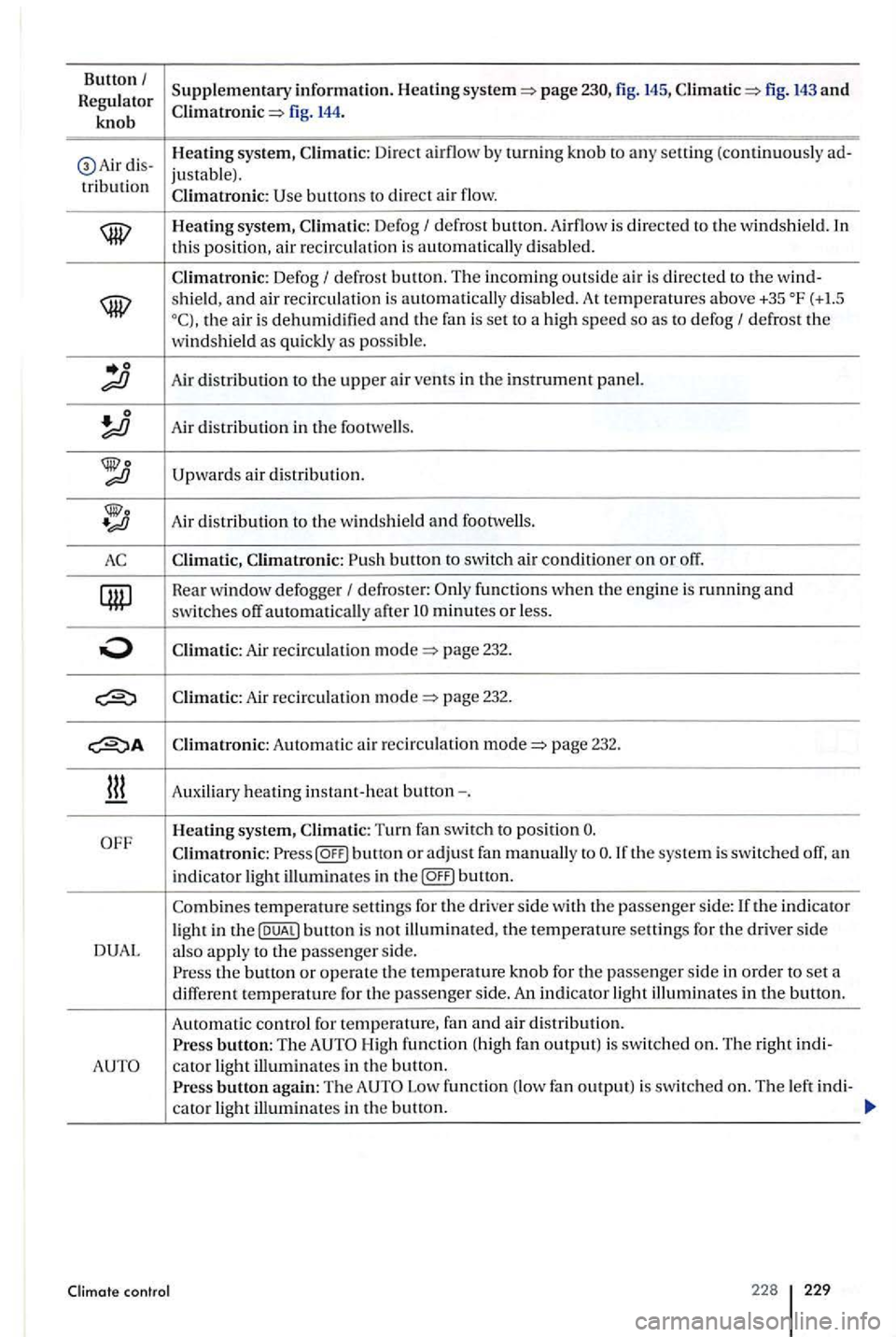
Button/ Supplementary information. Heating page 230, fig. 145, fig . 143 and Regulator knob fig . 144.
Air dis - H
eating system,
bullons to direct air flow.
Defog I defrost button. Airflow is directed to th e windshi eld . this position, air re cir culation is a utoma tically disab le d .
C limatronic: Defog
I defrost bulton. T he incomin g outsid e a ir is directed to the w ind-shie ld , and air recirculation is automatica lly disab le d. A t temperatures above +35 (+1.5 the air i s dehumidified and the fa n i s set to a hig h speed so as to defog I defrost the windshield as quickly as possible .
Air distribution to the upper a ir ve nts in the instrument panel.
A ir distribution in th e footw ells.
A ir distribution to the windsh ie ld and footwells.
bullon to swit ch air conditi oner o n or off.
Rear window defogger I defro ste r: fun ction s when the engine is nmning and switches off automatically after
Air rec ircu lation page 232.
Air r eci rc u lation page 232.
Climatron ic: Auto mati c air recircu lation page 232.
Auxil iary heating insta nt -h eat button-.
Heating system, Turn fan switch to position
or adj ust fan manually to the system is swit ched off, an
indi cator light ill
uminates i n th e button.
th e indicator
ligh t in th e butto n is no t illum in a te d, the tempera ture se11ings for the driver side a ls o apply to th e passenger side. th e button or operate th e temperature knob fo r the passenge r side in order to set a
differ ent temperature for the passenger sid e. An ind ica tor light illuminates in the button.
A
utomatic control for tempe rature, fa n and air distributi on. button: The High function (hi gh fan output) is switch ed on. The right indi -cator ligh t illuminat es in the b utton. button again: The